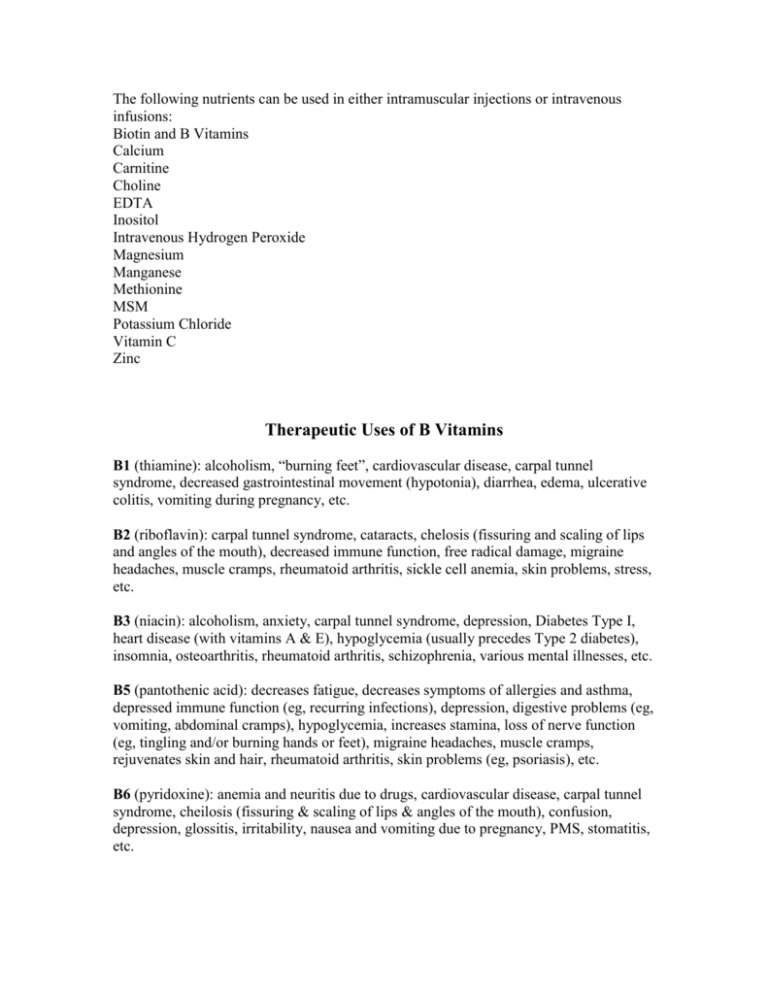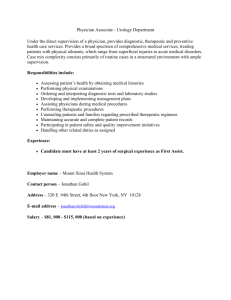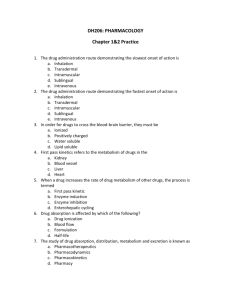IV Ingredients
advertisement

The following nutrients can be used in either intramuscular injections or intravenous infusions: Biotin and B Vitamins Calcium Carnitine Choline EDTA Inositol Intravenous Hydrogen Peroxide Magnesium Manganese Methionine MSM Potassium Chloride Vitamin C Zinc Therapeutic Uses of B Vitamins B1 (thiamine): alcoholism, “burning feet”, cardiovascular disease, carpal tunnel syndrome, decreased gastrointestinal movement (hypotonia), diarrhea, edema, ulcerative colitis, vomiting during pregnancy, etc. B2 (riboflavin): carpal tunnel syndrome, cataracts, chelosis (fissuring and scaling of lips and angles of the mouth), decreased immune function, free radical damage, migraine headaches, muscle cramps, rheumatoid arthritis, sickle cell anemia, skin problems, stress, etc. B3 (niacin): alcoholism, anxiety, carpal tunnel syndrome, depression, Diabetes Type I, heart disease (with vitamins A & E), hypoglycemia (usually precedes Type 2 diabetes), insomnia, osteoarthritis, rheumatoid arthritis, schizophrenia, various mental illnesses, etc. B5 (pantothenic acid): decreases fatigue, decreases symptoms of allergies and asthma, depressed immune function (eg, recurring infections), depression, digestive problems (eg, vomiting, abdominal cramps), hypoglycemia, increases stamina, loss of nerve function (eg, tingling and/or burning hands or feet), migraine headaches, muscle cramps, rejuvenates skin and hair, rheumatoid arthritis, skin problems (eg, psoriasis), etc. B6 (pyridoxine): anemia and neuritis due to drugs, cardiovascular disease, carpal tunnel syndrome, cheilosis (fissuring & scaling of lips & angles of the mouth), confusion, depression, glossitis, irritability, nausea and vomiting due to pregnancy, PMS, stomatitis, etc. B9 (folic acid): acne, AIDS, candidiasis, cataracts, cervical dysplasia, cervical, lung, and colon cancer, constipation, depression, headaches, heart disease and stroke, infertility, macrocytic anemia, mental illness, osteoporosis, prevent birth defects, rheumatoid arthritis, sickle cell anemia, and functions with B12 in many bodily processes. B12 (cobalamin): confusion, fatigue caused by megaloblastic anemia or pernicious anemia, loss of memory, low white blood cell and platelet counts, moodiness, paresthesias (prickling, tingling, and burning) of the hands and feet, psychosis, reduces the risk for cardiovascular disease (along with B6 & B9) unsteadiness, weakness, etc. BIOTIN (vitamin H): controls blood sugar in diabetics, diabetic neuropathy, gray hair, hair loss, intestinal candidiasis, nail problems, skin disorders, works closely with B5, B9, & B12, etc. Therapeutic Uses of Calcium Used in cardiovascular disease to reduce heart irregularity and lower cholesterol Used in dental disease to improve loose teeth, gingivitis, and periodontal disease Used in menopause to reduce depression, headaches, insomnia, and irritability Used in pregnancy to reduce pregnancy-induced hypertension and prevent pre-eclampsia Used in premenstrual syndrome (PMS) to relieve menstrual cramps, irritability or apprehension, and muscle cramps Used in the treatment of hypertension to reduce blood pressure (most effective in the elderly, persons of African descent, and salt-sensitive hypertensive patients) Used in the treatment of osteoporosis to preserve adequate mineral mass, prevent loss of structural bone components, maximize repair of damaged bones, and prevent loss of bone mass Increased calcium loss is caused by: alcohol consumption, aluminum-containing antacids, caffeine, high intake of sodium, high intake of phosphorus, high protein intake from supplements or special diets, saturated fat, and sugar. NOTE: Nutritional toxicity is an increase in blood calcium levels (hypercalcemia) because intake is too high, or an increase of urine calcium excretion resulting in calcification of the kidneys or development of renal stones. Results of hypercalcemia include: coma, confusion, constipation, decreased gastrointestinal and muscle tone, emotional deterioration, kidney failure, large urine volumes, nausea, and ultimately death. Doses of 5,000+ mg/day are toxic. Therapeutic Uses of Carnitine Aids in weight loss Can also be used to treat cognitive disorders, as well as depression Enhances the effectiveness of the antioxidant vitamins E and C Has the ability to lower blood triglyceride levels Helps to ease the severe pain of intermittent claudication Improves the motility of sperm Improves muscle strength in people with neuromuscular disorders Increases the use of fat as an energy source Induces alcohol-induced fatty liver Lessens the risk of heart disorders Major source of energy for muscles May be useful in treating Alzheimer's disease May be useful in treating chronic fatigue syndrome (CFS) [studies have shown decreased carnitine levels in many people with CFS] Prevents fatty buildup, especially in the heart, liver, and skeletal muscles Reduces health risks associated with diabetes by increasing fat metabolism Synthesis of carnitine depends on adequate levels of iron, B1, B6, vitamin C, and the amino acids lysine and methionine in the body Treatment with carnitine reduces damage to the heart from cardiac surgery Vegetarians are more likely to be deficient in carnitine because it is not found in vegetable protein Works with antioxidants to help slow the aging process by promoting the synthesis of an enzyme in brain cells that is vital for the production of cellular energy there Therapeutic Uses of Choline Aids in fat and cholesterol metabolism Aids in hormone production Beneficial for nervous system disorders such as Parkinson's disease and tardive dyskinesia Brain function and memory are impaired without choline Gallbladder regulation Important for reproduction and fetal development Liver function Lecithin formation May be needed for prevention and treatment of arteriosclerosis and the metabolism of homocysteine Minimizes excess fat in the liver Needed for the proper transmission of nerve impulses Plays an important role in cardiovascular health Deficiency may result in: cardiac symptoms, fatty buildup in the liver, gastric ulcers, high blood pressure, inability to digest fats, kidney impairment, liver impairment, and/or stunted growth. Therapeutic Uses of EDTA Immune dysregulation disorders/diseases due to inhibition of Nfkappa Improves blood flow and therefore beneficial in treating cardiovascular disease Rheumatoid arthritis due to inhibition of Nfkappa Used in the treatment of: brain and renal function diseases, macular degeneration, arthritis and arteriosclerosis Used to remove lead and other heavy metals from the body CAUTION: due to EDTA’s high affinity for calcium, calcium must be supplemented at opposite times when using EDTA to avoid issues of calcium deficiency. Therapeutic Uses of Intravenous Hydrogen Peroxide Used to treat: Arthritis Asthma Atherosclerosis Cancer Candidiasis (yeast) The common cold Gangrene Emphysema Epstein-Barr virus Influenza Sinus infection Viral infections In living systems oxygen (as O2) is transported by hemoglobin, a protein found in red blood cells. This is a highly efficient way of conducting oxygen from the lungs to the tissues of the body and insuring it does not react with anything along the way. Because it is bound by hemoglobin, it is unable to react to anything else until it is released by the hemoglobin (which then picks up carbon dioxide and transports it to the lungs). Hydrogen peroxide is a part of normal metabolism. Your body produces it constantly. There are units in certain white blood cells called "peroxisomes," which produce H2O2. These white cells then engulf bacteria which cause disease and mix them together with these peroxisomes. They both then disappear as the singlet oxygen from H2O2 destroys the bacteria or virus. This happens naturally, without any help from outside sources of hydrogen peroxide. The effect of singlet oxygen in the human body is twofold. It kills, or severely inhibits the growth of, anaerobic organisms (bacteria and viruses that use carbon dioxide for fuel and leave oxygen as a by-product). This action is immediate, on contact with the anaerobic organism. Anaerobic bacteria are pathogens, the organisms which cause disease. All viruses are anaerobic. Aerobic bacteria found in the human intestine are friendly bacteria which aid digestion and improve immune function. These organisms thrive in the presence of hydrogen peroxide. Intravenous hydrogen peroxide is used to dissolve cholesterol and calcium deposits associated with atherosclerosis. Research in the 1960s at Baylor University showed conclusively that intra-arterial hydrogen peroxide dissolves plaque in large arteries. This makes H2O2 a wonderful complement to EDTA in the treatment of vascular disease, as EDTA has been shown to clear small vessels and create collateral circulation around large vessel blockages. This combination is called "Chelox Therapy." It also clears the lungs, in cases of emphysema, by producing oxygen bubbles in the alveoli (tiny air sacs in the lungs), literally lifting the mucus deposits up, so they can be coughed out. It also debrides the lungs which is very helpful in treating asthma and asthma attacks. Hydrogen peroxide has a remarkable clearing effect on the skin. After only a few intravenous treatments the skin takes on a translucent clarity usually seen only in children. Therapeutic Uses of Inositol Has a calming effect Helps to prevent hardening of the arteries Helps to reduce cholesterol levels Helps to remove fats from the liver Important in the formation of lecithin Important in the metabolism of fat and cholesterol Vital for hair growth Deficiency can lead to: arteriosclerosis, constipation, elevated cholesterol levels, hair loss, irritability, mood swings, and skin eruptions. High doses may help in the treatment of: anxiety disorders, depression, and obsessivecompulsive disorder. Therapeutic Uses of Magnesium Helps prevent noise-induced hearing loss Helps to prevent kidney stones Helps relieve constipation by pulling water into the large intestine Improves peripheral circulation and visual field Improves sleep to restore normal energy levels Reduces nervousness, anxiety, and depression Relieves PMS symptoms like cramps, depression, fatigue, irritability, and water retention Used in cardiovascular disease to: improve cholesterol and triglyceride levels, prevents atherosclerosis and myocardial infarction, reduce angina, reduce high blood pressure, and helps to prevent strokes and cardiac arrhythmias. Used in Diabetes Types I and II to improve insulin action and glucose metabolism Used to halt acute asthma attacks and exacerbations of COPD Magnesium is used in over 350 metabolic reactions in the body and is therefore essential for: amino acid activation, the citric acid cycle, the glycolytic cycle, and lipid metabolism. Its primary function is as an enzyme cofactor, thus producing energy, synthesizing lipids and proteins, regulating calcium flow and parathyroid hormone (PTH) secretion, forming urea, and relaxing muscles. Vitamin B6 works with magnesium in many enzyme systems and assists in the body’s accumulation of magnesium. Common foods sources: almonds, baked potatoes (with skin), bananas, blackstrap molasses, black walnuts, Brazil nuts, cashews, cocoa powder, green leafy vegetables, legumes, oatmeal, peanuts, pine nuts, pistachio nuts, pumpkin and squash seeds, seaweeds, soybean flour, tofu, wheat bran, and whole grains . Therapeutic Uses of Manganese Aids in the formation of breast milk Blood sugar regulation Essential for people with iron-deficiency anemia Key element in the production of certain enzymes such as superoxide dismutase (SOD) Necessary for bone synthesis Needed for a healthy immune system Needed for protein and fat metabolism Needed for healthy nerves Needed for the utilization of vitamin B1 and vitamin E Required for normal bone growth Required for reproduction Used in energy production Used in the formation of cartilage and synovial fluid of the joints Works well with the b-complex vitamins to give an overall feeling of well-being Deficiency may lead to: atherosclerosis, confusion, convulsions, eye problems, hearing disorders, high cholesterol levels, hypertension, irritability, memory loss, muscle contractions, pancreatic damage, profuse perspiration, rapid pulse, teeth grinding (bruxism), tremors, and tendency toward breast ailments. Therapeutic Uses of Methionine METHIONINE MUST BE OBTAINED FROM FOOD SOURCES OR SUPPLEMENTS Assists in the breakdown of fats Beneficial for chemical allergies Beneficial for osteoporosis Beneficial for women who take oral contraceptives because it promotes the excretion of estrogen Good source of sulfur, which in-actives free radicals Helps the digestive system Helps diminish muscle weakness Prevents buildup of fats in the liver Helps to detoxify harmful agents such as lead and other heavy metals Helps to prevent skin and nail problems Powerful antioxidant Prevents buildup of fat in the arteries that might obstruct blood flow to the brain, heart, and kidneys Prevents brittle hair Protects against radiation Protects depletion of glutathione (a powerful antioxidant) which protects the liver from the damaging effects of toxic compounds Reduces the level of histamine in the body Required for the synthesis of collagen Required for the synthesis of nucleic acids Required for the synthesis of proteins found in every cell of the body Synthesis of the amino acids cysteine and taurine may depend on the availability of methionine Used to make choline (a brain food) therefore it is wise to supplement with choline to prevent depletion of methionine Useful in the treatment of rheumatic fever Useful in the treatment of toxemia of pregnancy Useful with Gilbert's syndrome, an anomaly of liver function Therapeutic Uses of MSM Aids immune function Detoxifies the body on cellular level Heals injuries Increases speed and efficiency of transportation of nutrients into cells Nourishes the hair, skin, and nails Promotes gastrointestinal health Relieves pain and inflammation Reduces allergy problems May benefit patients with: arthritis, heartburn, lung problems, migraines, and muscle pain. Therapeutic Uses of Potassium Potassium is vital in the human body and best absorbed when taken with B6! Needed for building muscles, growth, heart activity, transmission of nerve impulses, etc It can be used as a salt substitute for food (but is usually mixed with regular salt, sodium chloride, to improve the taste) One of the major electrolytes in your body, along with sodium and chloride. Potassium and sodium work together like a molecular seesaw: when the level of one goes up, the other goes down. All together, these three dissolved minerals play an intimate chemical role in every function of your body. Treats metabolic alkalosis Used in preventing kidney stones Used in the treatment of hypokalemia and associated conditions, for digitalis poisoning, and as an electrolyte replenisher Deficiencies may result in: acne, cramping legs, dry skin, fatigue, irregular heartbeat (arrhythmias), mood changes, muscle weakness, and slow reflexes. Side effects can include gastrointestinal discomfort including nausea and vomiting, diarrhea and bleeding of the gut. Overdoses cause: hyperkalemia which can lead to parethesia, cardiac conduction blocks, fibrillation and arrhythmias, sclerosis, and even death. Therapeutic Uses of Vitamin C VITAMIN C MUST BE OBTAINED THROUGH THE DIET OR SUPPLEMENTS Aids in the production of anti-stress hormones Aids in the production of interferon, an important immune system protein An antioxidant that is required for at least 300 metabolic functions in the body Attacks free radicals and biologic fluids Can combine with toxic substances, such as heavy metals, and render them harmless Can reduce symptoms of asthma Essential in the formation of collagen Helps to prevent cancer Increases the absorption of iron May help to prevent atherosclerosis May lower high blood pressure May reduce levels of LDL while increasing levels of HDL May reduce the risk of cataracts Needed for the metabolism of folic acid, tyrosine, and phenylalanine Promotes healing of wounds and burns Protects against abnormal clotting and bruising Protects against infection by enhancing immunity Protects against the harmful effects of pollution Required for tissue growth and repair Required for adrenal gland function Required for healthy gums Works synergistically with vitamin E and beta-carotene Signs of Vitamin C deficiency: edema; gums that bleed when brushed; increased susceptibility to infection especially colds and bronchial infections; joint pains; lack of energy; poor digestion; prolonged wound healing time; tendency to bruise easily; tooth loss. Therapeutic Uses of Zinc Improves male fertility and sexual function, especially among smokers Improves wound healing May prevent macular degeneration Preserves the sense of taste during cancer treatments (although, excess daily amounts can permanently destroy the sense of taste) Treats and may prevent acne Treats anorexia nervosa (anorexia is a symptom of zinc deficiency and the teenage population is at higher risk for zinc deficiency due to dietary habits) Treats depressed immunity Treats rheumatoid arthritis Treats Wilson's disease (excess copper storage disorder)








